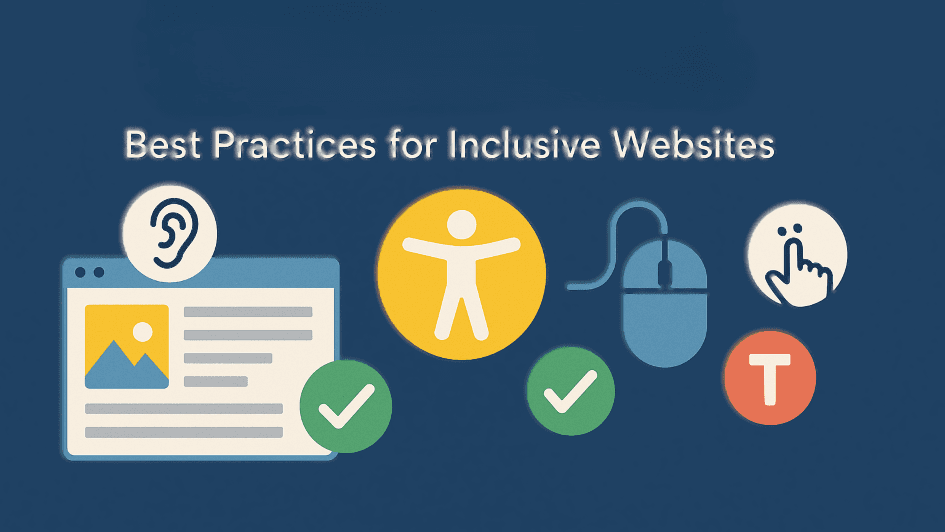Designing for Accessibility: Best Practices for Inclusive Websites
Creating an accessible website isn’t just about compliance—it’s about ensuring equal access to digital experiences for everyone, including users with disabilities.
AMV Team
Author

Creating an accessible website isn’t just about compliance—it’s about ensuring equal access to digital experiences for everyone, including users with disabilities. As web developers and business owners, designing with accessibility in mind improves usability, customer satisfaction, SEO, and even legal compliance.
Let’s explore the best practices for designing inclusive, accessible websites that work for all users.
👁️ 1. Use Semantic HTML
Semantic HTML provides meaningful structure to your content, helping both screen readers and search engines understand it.
✅ Best practices:
- Use headings (
<h1>to<h6>) in a logical order - Use lists (
<ul>,<ol>) and table elements properly - Ensure form labels are associated with their inputs (
<label for="id">)
🔎 Business benefit: Improves SEO performance and reduces development time for assistive tech integration.
🌈 2. Ensure Sufficient Color Contrast
Poor contrast can make content unreadable for users with low vision or color blindness.
✅ Best practices:
- Use a contrast ratio of at least 4.5:1 for normal text
- Avoid relying on color alone to convey meaning
- Use tools like WebAIM Contrast Checker to validate color choices
🔎 Business benefit: Enhances readability and boosts user engagement on all devices.
🎧 3. Make Your Website Keyboard Navigable
Some users rely solely on keyboards or switch devices to navigate.
✅ Best practices:
- Ensure all interactive elements (links, buttons, forms) are reachable via the Tab key
- Maintain a visible focus indicator for elements in focus
- Avoid keyboard traps (elements that trap focus)
🔎 Business benefit: Increases usability for power users, people with motor impairments, and screen reader users.
🧏 4. Provide Text Alternatives for Non-Text Content
Every image, video, or icon should have a textual description for screen reader users.
✅ Best practices:
- Use descriptive
alttext for images - Provide captions and transcripts for audio/video content
- Label icons with
aria-labelor visible text where needed
🔎 Business benefit: Improves accessibility while enhancing search engine indexing of multimedia content.
📲 5. Design Responsive and Flexible Layouts
Accessibility extends to device compatibility. Make sure your site works well on mobile, tablet, and desktops.
✅ Best practices:
- Use responsive grids and media queries
- Support zooming without breaking layout (avoid fixed pixel values)
- Design with reflow in mind for screen magnifiers
🔎 Business benefit: Improves mobile SEO, bounce rate, and user satisfaction.
🎙️ 6. Implement ARIA (Accessible Rich Internet Applications) Landmarks Wisely
ARIA roles and attributes help screen readers interpret complex UIs, but should be used with care.
✅ Best practices:
- Use ARIA only when native HTML doesn't suffice
- Implement roles like
role="navigation",role="main",aria-live - Keep ARIA use semantic and consistent
🔎 Business benefit: Enables richer, more dynamic UIs without compromising accessibility.
🧠 7. Write Clear and Consistent Content
Accessible websites aren’t just about code—they also rely on clear, understandable content.
✅ Best practices:
- Use plain language and avoid jargon
- Organize content with bullet points and short paragraphs
- Include descriptive links like “View Product Details” instead of “Click here”
🔎 Business benefit: Increases clarity for all users, especially those with cognitive disabilities or low literacy.
🧪 8. Test with Real Assistive Technologies
No accessibility strategy is complete without user testing.
✅ Best practices:
- Test with screen readers (NVDA, VoiceOver, JAWS)
- Use keyboard-only navigation
- Perform audits using tools like WAVE, axe, or Lighthouse
🔎 Business benefit: Validates accessibility claims and reduces risk of ADA or WCAG compliance issues.
🔐 9. Consider Accessibility from the Start
Accessibility shouldn’t be an afterthought—it should be embedded in your design and development workflow.
✅ Best practices:
- Include accessibility in your design system
- Educate your dev and content teams on WCAG standards
- Involve people with disabilities in the UX testing process
🔎 Business benefit: Saves cost and time versus retrofitting accessibility later—and builds a brand known for inclusivity.
🚀 Building Inclusive Digital Experiences
Designing accessible websites is not only a technical responsibility but also a moral and business imperative. With 1 in 5 people living with some form of disability, creating inclusive websites ensures you’re serving all users, improving your reach, and building stronger trust.
Let’s not design for the average user—let’s design for everyone.
Want help auditing your site for accessibility or building WCAG-compliant web solutions? Contact our team to make your website inclusive and future-ready.